The Role of Social Networks in Agricultural Adaptation to Climate Change: Implications for Sustainable Agriculture in Pakistan
Abstract
:1. Introduction
2. Materials and Methods
2.1. Case Study
2.2. Social Network Analysis
2.2.1. Structural Holes
2.2.2. Density
2.3. Data Collection and Analysis
3. Results and Discussion
3.1. Descriptive Statistics
3.2. Climate Change Impacts and Adaptation Strategies
3.3. Linking Climate Change Adaptation Social Networks and Institutional Services
3.3.1. Institutions Providing on-Farm Services
3.3.2. Farmers’ Access to Institutional Services
3.3.3. The Institutional-Services–Farmers Network
3.3.4. Structural Gaps in Current Institutional Support
3.3.5. Adoption of Different Adaptation Measures and Access to Institutional Services
3.4. Enhancing the Role of Local Stakeholders in Adaptation to Climate Change
4. Conclusions
Acknowledgments
Author Contributions
Conflicts of Interest
Appendix A
| Factors in Networks | Acronyms |
|---|---|
| 1. Adaptation Network | CA_Access |
| Public extension services | ExtenPub |
| Private extension services | ExtenPrv |
| Community extension services | ExtenCom |
| Weather information public sources | WeathPub |
| Weather information private sources | WeathPrv |
| Weather information community sources | WeathCom |
| Water delivery information public sources | WatPub |
| Water delivery information private sources | WatPrv |
| Water delivery information community sources | WatCom |
| 2. Financial support network | Fin_Support |
| Agricultural credit public sources | CreditPub |
| Agricultural credit private sources | CreditPrv |
| Agricultural credit community sources | CreditCom |
| Marketing information public sources | InfoPub |
| Marketing information private sources | InfoPrv |
| Marketing information community sources | InfoCom |
| Post-harvest processing public sources | PostharPub |
| Post-harvest processing private sources | PostharPrv |
| Post-harvest processing community sources | PostharCom |
| Marketing of agricultural products public sources | MarkPub |
| Marketing of agricultural products private sources | MarkPrv |
| Marketing of agricultural products community sources | MarkCom |
| Farm machinery and implements public sources | MachPub |
| Farm machinery and implements private sources | MachPrv |
| Farm machinery and implements community sources | MachCom |
References
- Abid, M.; Schilling, J.; Scheffran, J.; Zulfiqar, F. Climate change vulnerability, adaptation and risk perceptions at farm level in Punjab, Pakistan. Sci. Total Environ. 2016, 547, 447–460. [Google Scholar] [CrossRef] [PubMed]
- Abid, M.; Scheffran, J.; Schneider, U.; Ashfaq, M. Farmers’ perceptions of and adaptation strategies to climate change and their determinants: The case of Punjab province, Pakistan. Earth Syst. Dyn. 2015, 6, 225–243. [Google Scholar] [CrossRef]
- IUCN. Climate Change; Vulnerabilities in Agriculture in Pakistan. 2009. Available online: http://cmsdata.iucn.org/downloads/pk_cc_agr_vul.pdf (accessed on 10 August 2016).
- Kreft, S.; Eckstein, D. Global Climate Risk Index 2014: Who Suffers Most from Extreme Weather Events? Weather-Related Loss Events in 2012 and 1993 to 2012; Germanwatch eV: Bonn, Germany, 2013. [Google Scholar]
- Intergovernmental Panel on Climate Change (IPCC). Mitigation of Climate Change, IPCC Special Report on Renewable Energy Sources and Climate Change Mitigation 2011; IPCC: Geneva, Switzerland, 2011. [Google Scholar]
- Government of Pakistan (GOP). Pakistan: Flood Impact Assessment; Special Section: Economic Survey of Pakistan; Ministry of Finance; Government of Pakistan: Islamabad, Pakistan, 2011.
- Adger, W.N.; Huq, S.; Brown, K.; Conway, D.; Hulme, M. Adaptation to climate change in the developing world. Prog. Dev. Stud. 2003, 3, 179–195. [Google Scholar] [CrossRef]
- Bryan, E.; Ringler, C.; Okoba, B.; Roncoli, C.; Silvestri, S.; Herrero, M. Adapting Agriculture to Climate Change in Kenya: Household and Community Strategies and Determinants; ILRI Report to the World Bank for the Project “Adaptation of Smallholder Agriculture to Climate Change in Kenya; George Washington University: Washington, DC, USA, 2011. [Google Scholar]
- Bryan, E.; Ringler, C.; Okoba, B.; Roncoli, C.; Silvestri, S.; Herrero, M. Adapting agriculture to climate change in Kenya: Household strategies and determinants. J. Environ. Manag. 2013, 114, 26–35. [Google Scholar] [CrossRef] [PubMed]
- Bryant, C.R.; Smit, B.; Brklacich, M.; Johnston, T.R.; Smithers, J.; Chjotti, Q.; Singh, B. Adaptation in Canadian agriculture to climatic variability and change. Clim. Chang. 2000, 45, 181–201. [Google Scholar]
- Agrawal, A. Local institutions and adaptation to climate change. In Social Dimensions of Climate Change: Equity and Vulnerability in a Warming World; The World Bank: Washington, DC, USA, 2010; pp. 173–198. [Google Scholar]
- Smit, B.; Wandel, J. Adaptation, adaptive capacity and vulnerability. Glob. Environ. Chang. 2006, 16, 282–292. [Google Scholar] [CrossRef]
- Stringer, L.C.; Dyer, J.C.; Reed, M.S.; Dougill, A.J.; Twyman, C.; Mkwambisi, D. Adaptations to climate change, drought and desertification: Local insights to enhance policy in Southern Africa. Environ. Sci. Policy 2009, 12, 748–765. [Google Scholar] [CrossRef]
- Kiragu, S. The Role of Local Institutions in Shaping Climate Risks Adaptation Processes and Practices among the Semi-Arid Rural Households of Mwingi, Kenya; Universität Bayreuth: Bayreuth, Germany, 2010. [Google Scholar]
- McCarl, B.A.; Schneider, U.A. The cost of greenhouse gas mitigation in US agriculture and forestry. Science 2001, 294, 2481–2482. [Google Scholar] [CrossRef] [PubMed]
- Metz, B.; Davidson, O.; Bosch, P.; Dave, R.; Meyer, L. Mitigation of Climate Change; Cambridge University Press: Cambridge, UK, 2007. [Google Scholar]
- Mendelsohn, R. The Impact of Climate Change on Agriculture in Asia. J. Integr. Agric. 2014, 13, 660–665. [Google Scholar] [CrossRef]
- Reed, B.; Mendelsohn, R.; Abidoye, B.O. The economics of crop adaptation to climate change in South-East Asia. Clim. Chang. Econ. 2017, 8, 1740002. [Google Scholar] [CrossRef]
- Alam, M.M.; Siwar, C.; Bin Toriman, M.E.; Molla, R.I.; Talib, B. Climate change induced adaptation by paddy farmers in Malaysia. Mitig. Adapt. Strateg. Glob. Chang. 2012, 17, 173–186. [Google Scholar] [CrossRef]
- Deressa, T.T.; Hassan, R.M.; Ringler, C. Perception of and adaptation to climate change by farmers in the Nile basin of Ethiopia. J. Agric. Sci. 2011, 149, 23–31. [Google Scholar] [CrossRef]
- Mugi-Ngenga, E.; Mucheru-Muna, M.; Mugwe, J.; Ngetich, F.; Mairura, F.; Mugendi, D. Household’s socio-economic factors influencing the level of adaptation to climate variability in the dry zones of Eastern Kenya. J. Rural Stud. 2016, 43, 49–60. [Google Scholar] [CrossRef]
- Carlson, K.; McCormick, S. American adaptation: Social factors affecting new developments to address climate change. Glob. Environ. Chang. 2015, 35, 360–367. [Google Scholar] [CrossRef]
- Jordan, J.C. Swimming alone? The role of social capital in enhancing local resilience to climate stress: A case study from Bangladesh. Clim. Dev. 2015, 7, 110–123. [Google Scholar] [CrossRef]
- Kithiia, J. Resourceless victims or resourceful collectives: Addressing the impacts of climate change through social capital in fringing coastal communities. Ocean Coast. Manag. 2015, 106, 110–117. [Google Scholar] [CrossRef]
- Lei, Y.; Zhang, H.; Chen, F.; Zhang, L. How rural land use management facilitates drought risk adaptation in a changing climate—A case study in arid Northern China. Sci. Total Environ. 2016, 550, 192–199. [Google Scholar] [CrossRef] [PubMed]
- Paul, C.J.; Weinthal, E.S.; Bellemare, M.F.; Jeuland, M.A. Social capital, trust, and adaptation to climate change: Evidence from rural Ethiopia. Glob. Environ. Chang. 2016, 36, 124–138. [Google Scholar] [CrossRef]
- Alam, G.M.M.; Alam, K.; Mushtaq, S. Influence of institutional access and social capital on adaptation decision: Empirical evidence from hazard-prone rural households in Bangladesh. Ecol. Econ. 2016, 130, 243–251. [Google Scholar] [CrossRef]
- Chen, H.; Wang, J.; Huang, J. Policy support, social capital, and farmers’ adaptation to drought in China. Glob. Environ. Chang. 2014, 24, 193–202. [Google Scholar] [CrossRef]
- Deressa, T.T.; Hassan, R.M.; Ringler, C.; Alemu, T.; Yesuf, M. Determinants of farmers’ choice of adaptation methods to climate change in the Nile Basin of Ethiopia. Glob. Environ. Chang. 2009, 19, 248–255. [Google Scholar] [CrossRef]
- Wolf, J.; Adger, W.N.; Lorenzoni, I.; Abrahamson, V.; Raine, R. Social capital, individual responses to heat waves and climate change adaptation: An empirical study of two UK cities. Glob. Environ. Chang. 2010, 20, 44–52. [Google Scholar] [CrossRef]
- Abbas, F. Analysis of a historical (1981–2010) temperature record of the punjab Province of Pakistan. Earth Interact. 2013, 17, 1–23. [Google Scholar] [CrossRef]
- Hanif, U.; Syed, S.H.; Ahmad, R.; Malik, K.A.; Nasir, M. Economic impact of climate change on the agricultural sector of Punjab. Pak. Dev. Rev. 2010, 49, 771–798. [Google Scholar]
- Jeswani, H.K.; Wehrmeyer, W.; Mulugetta, Y. How warm is the corporate response to climate change? Evidence from Pakistan and the UK. Bus. Strategy Environ. 2011, 17, 46–60. [Google Scholar] [CrossRef]
- Siddiqui, R.; Samad, G.; Nasir, M.; Jalil, H.H. The impact of climate change on major agricultural crops: Evidence from Punjab, Pakistan. Pak. Dev. Rev. 2012, 51, 261–276. [Google Scholar]
- Ali, S.; Liu, Y.; Ishaq, M.; Shah, T.; Ilyas, A.; Din, I.U. Climate Change and Its Impact on the Yield of Major Food Crops: Evidence from Pakistan. Foods 2017, 6, 39. [Google Scholar] [CrossRef] [PubMed]
- Ahmad, M.; Iqbal, M.; Khan, M.A. Climate Change, Agriculture and Food Security in Pakistan: Adaptation Options and Strategies; Climate Change Brief; Pakistan Institute of Development Economics: Islamabad, Pakistan, 2013. [Google Scholar]
- Rahut, D.B.; Ali, A. Coping with Climate Change and its Impact on Productivity, Income, and Poverty: Evidence from the Himalayan Region of Pakistan. Int. J. Disaster Risk Reduct. 2017. [Google Scholar] [CrossRef]
- Gorst, A.; Groom, B.; Dehlavi, A. Crop Productivity and Adaptation to Climate Change in Pakistan; Working Paper No. 189; Grantham Research Institute on Climate Change and the Environment, London School of Economics and Political Science: London, UK, 2015; Available online: http://www.lse.ac.uk/GranthamInstitute/wp-content/uploads/2015/04/Working-Paper-189-Gorst-et-al.pdf (accessed on 9 June 2015).
- Saboor, A.; Hussain, M.; Munir, M. Impact of micro credit in alleviating poverty: An Insight from rural Rawalpindi, Pakistan. Pak. J. Life Soc. Sci. 2009, 7, 90–97. [Google Scholar]
- Abid, M.; Schneider, U.A.; Scheffran, J. Adaptation to climate change and its impacts on food productivity and crop income: Perspectives of farmers in rural Pakistan. J. Rural Stud. 2016, 47A, 254–266. [Google Scholar] [CrossRef]
- Bodin, Ö.; Prell, C. Social Networks and Natural Resource Management: Uncovering the Social Fabric of Environmental Governance; Cambridge University Press: Cambridge, UK, 2011. [Google Scholar]
- Ngaruiya, G.W.; Scheffran, J.; Lang, L. Social networks in water governance and climate adaptation in Kenya. In Sustainable Water Use and Management; Springer: Berlin/Heidelberg, Germany, 2015; pp. 151–167. [Google Scholar]
- Freeman, L. The Development of Social Network Analysis; A Study in the Sociology of Science; ΣP Empirical Press: Vancouver, BC, Canada, 2004. [Google Scholar]
- Prell, C.; Reed, M.; Racin, L.; Hubacek, K. Competing structure, competing views: The role of formal and informal social structures in shaping stakeholder perceptions. Ecol. Soc. 2010, 15, 34. [Google Scholar] [CrossRef]
- Wasserman, S.; Faust, K. Social Network Analysis: Methods and Applications; Cambridge University Press: Cambridge, UK, 1994; Volume 8. [Google Scholar]
- Ngaruiya, G.W.; Scheffran, J. Actors and networks in resource conflict resolution under climate change in rural Kenya. Earth Syst. Dyn. 2016, 7, 441. [Google Scholar] [CrossRef]
- Abid, M. Climate Change Impacts and Adaptation in the Agricultural Sector of Pakistan-Socioeconomic and Geographical Dimensions. Doctor’s Disseration, Department of Earth Sciences, Universität Hamburg, Hamburg, Germany, 2017. [Google Scholar]
- Borgatti, S.P.; Mehra, A.; Brass, D.J.; Labianca, G. Network analysis in the social sciences. Science 2009, 323, 892. [Google Scholar] [CrossRef] [PubMed]
- Abid, M.; Ashfaq, M.; Hassan, S.; Fatima, N. A resource use efficiency analysis of small Bt cotton farmers in Punjab, Pakistan. Pak. J. Agric. Sci. 2011, 48, 65–71. [Google Scholar]
- Government of Pakistan. Household Integrated Economic Survey 2015–2016; Pakistan Bureau of Statistics: Islamabad, Pakistan, 2016. Available online: http://www.pbs.gov.pk/sites/default/files/pslm/publications/hies15-16/write%20up%2015-16-HIES-final.pdf (accessed on 25 October 2017).
- Jan, I.; Khan, H.; Jalaluddin, M. Analysis of agricultural extension system: A discrepancy between providers and recipients of the extension services empirical evidence from North-West Pakistan. Sarhad J. Agric. 2008, 24, 349–354. [Google Scholar]
- Saqib, R.; Tachibana, S. Contribution of agricultural and forestry extension services to inclusive extension system in North-West Pakistan: A case study of Mansehra and Swat districts of Khyber Pakhtunkhwa Province. J. Agric. Ext. Rural Dev. 2014, 6, 175–187. [Google Scholar]
- Shahbaz, B.; Mbeyale, G.; Haller, T. Trees, trust and the state: A comparison of participatory forest management in Pakistan and Tanzania. J. Int. Dev. 2008, 20, 641–653. [Google Scholar] [CrossRef]
- Davidson, A.P.; Ahmad, M.; Ali, T. Dilemmas of Agricultural Extension in Pakistan: Food for Thought; Overseas Development Institute (ODI), Agricultural Research & Extension Network (AgREN): London, UK, 2001. [Google Scholar]
- Luqman, M.; Shahbaz, B.; Ali, S.; Butt, T.M.; Ashraf, S. Rural Women’s Involvement and Their Constraints in Accessing Livestock Extension Services in District Faisalabad-Pakistan. Glob. Vet. 2014, 12, 550–556. [Google Scholar]
- Yaseen, M.; Xu, S.; Yu, W.; Hassan, S. Farmers’ access to agricultural information sources: Evidences from rural Pakistan. J. Agric. Chem. Environ. 2016, 5, 12. [Google Scholar] [CrossRef]
- Rahman, S.U.; Hussain, A.; Taqi, M. Impact of agricultural credit on agricultural productivity in Pakistan: An empirical analysis. Int. J. Adv. Res. Manag. Soc. Sci. 2014, 3, 125–139. [Google Scholar]
- Hussain, A.; Thapa, G.B. Smallholders’ access to agricultural credit in Pakistan. Food Secur. 2012, 4, 73–85. [Google Scholar] [CrossRef]
- Amjad, S.; Hasnu, S.A.F. Smallholders’ access to rural credit: Evidence from Pakistan. Lahore J. Econ. 2007, 12, 1–25. [Google Scholar]
- Meinzen-Dick, R.; Bernier, Q.; Haglund, E. The Six ‘ins’ of Climate-Smart Agriculture: Inclusive Institutions for Information, Innovation, Investment and Insurance; International Food Policy Research Institute (IFPRI): Washington, DC, USA, 2013. [Google Scholar]
- Glendenning, C.J.; Babu, S.; Asenso-Okyere, K. Review of Agricultural Extension in India: Are Farmers Information Needs Being Met; IFPRI Discussion Paper; The International Food Policy Research Institute: Washington, DC, USA, 2010. [Google Scholar]
- Hoang, L.A.; Castella, J.C.; Novosad, P. Social networks and information access: Implications for agricultural extension in a rice farming community in northern Vietnam. Agric. Hum. Values 2006, 23, 513–527. [Google Scholar] [CrossRef]
- Biagini, B.; Miller, A. Engaging the private sector in adaptation to climate change in developing countries: Importance, status, and challenges. Clim. Dev. 2013, 5, 242–252. [Google Scholar] [CrossRef]
- Nelson, G.C. Agriculture and Climate Change: An Agenda for Negotiation in Copenhagen; Policy Paper Number; The International Food Policy Research Institute: Washington, DC, USA, 2009; Volume 16. [Google Scholar]
- Binswanger, H.P. Attitudes toward risk: Theoretical implications of an experiment in rural India. Econ. J. 1981, 91, 867–890. [Google Scholar] [CrossRef]
- Meinzen-Dick, R.; Quisumbing, A.; Behrman, J.; Biermayr-Jenzano, P.; Wilde, V.; Noordeloos, M.; Beintema, N. Engendering Agricultural Research, Development and Extension; The International Food Policy Research Institute: Washington, DC, USA, 2011; Volume 176. [Google Scholar]
- Senanayake, N.; Mukherji, A.; Giordano, M. Re-visiting what we know about Irrigation Management Transfer: A review of the evidence. Agric. Water Manag. 2015, 149, 175–186. [Google Scholar] [CrossRef]
- GOP. Subsidies for Farmers, Government of Punjab, Pakistan. 2016. Available online: http://www.ofwm.agripunjab.gov.pk/info_subsidies (accessed on 6 October 2016).
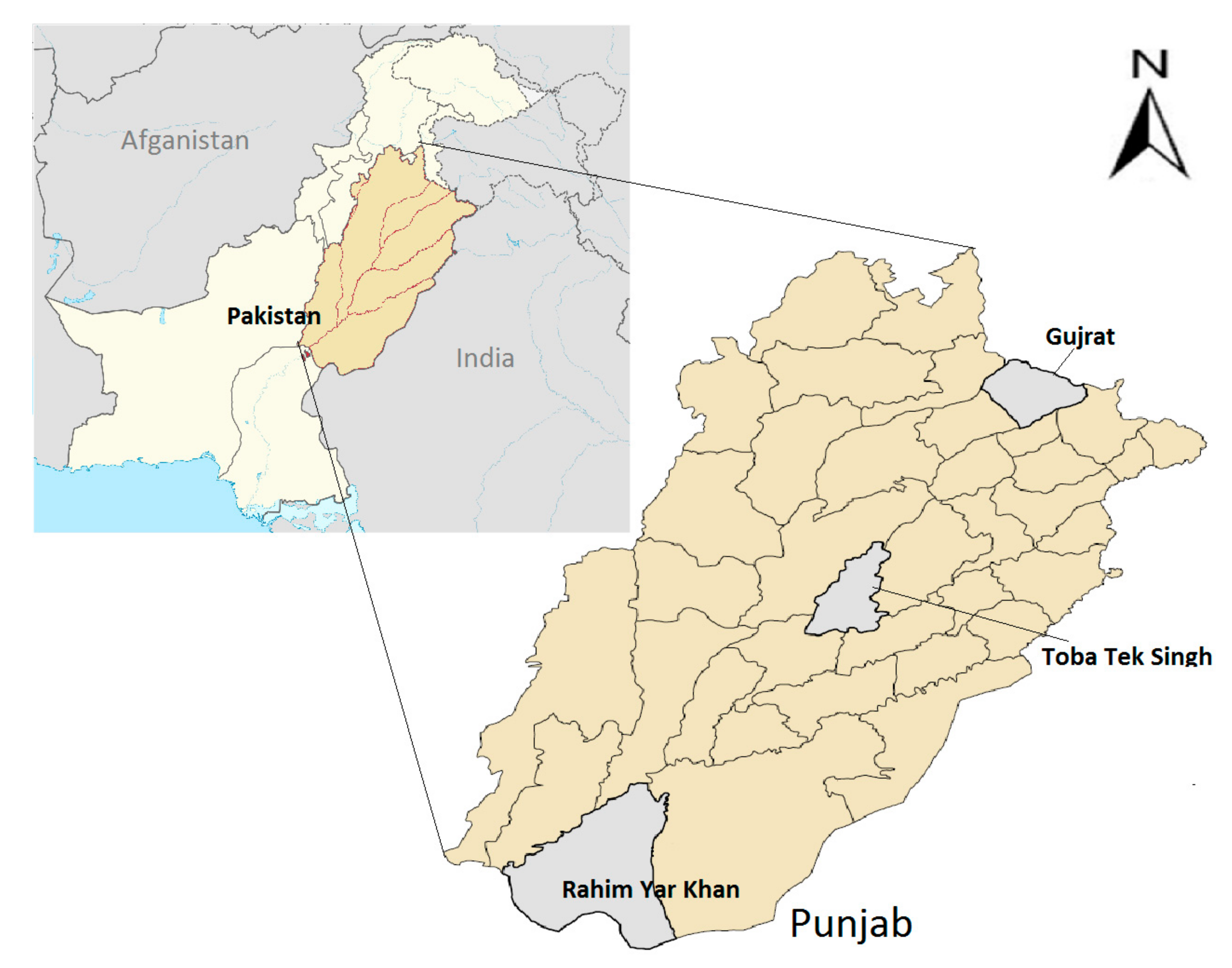
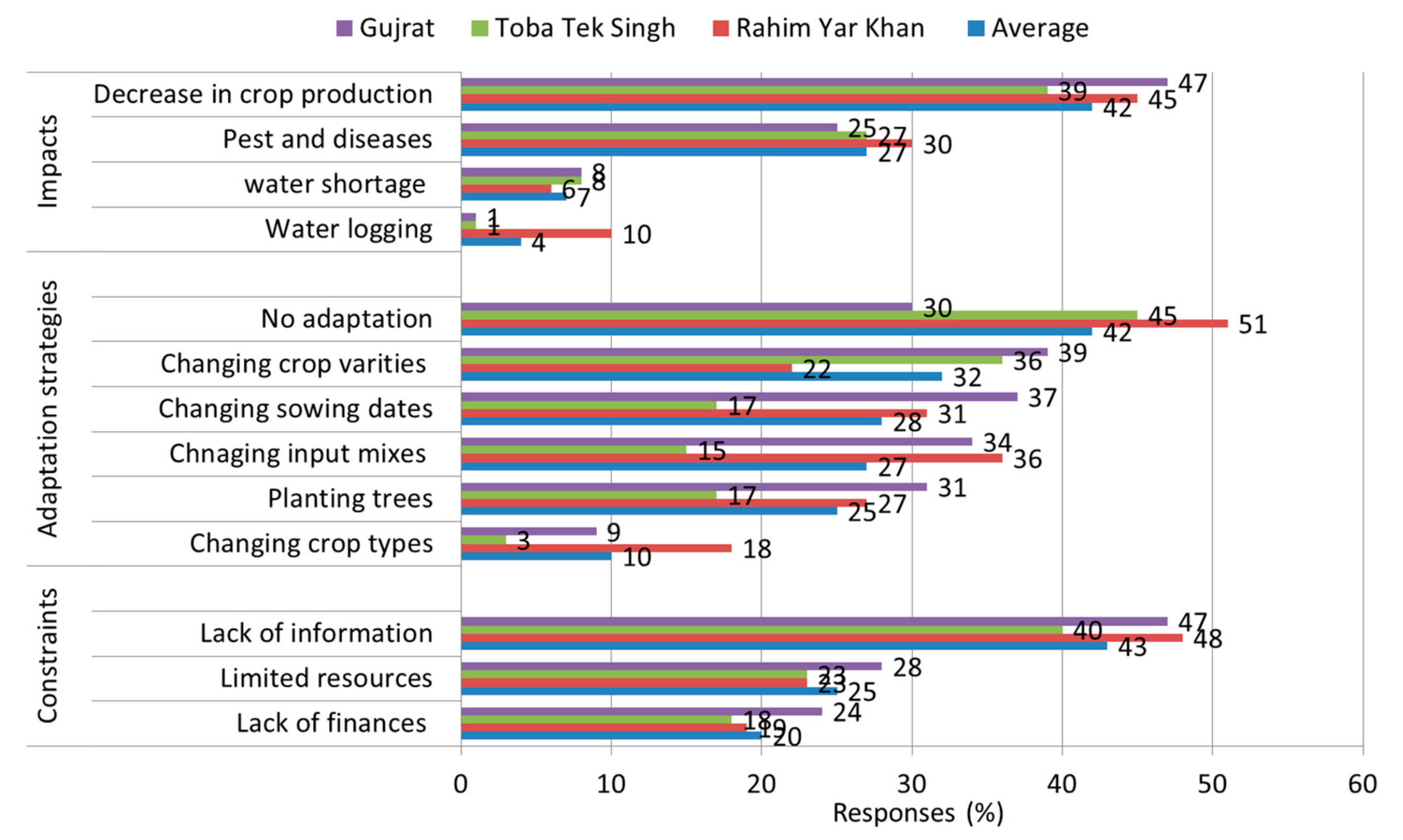

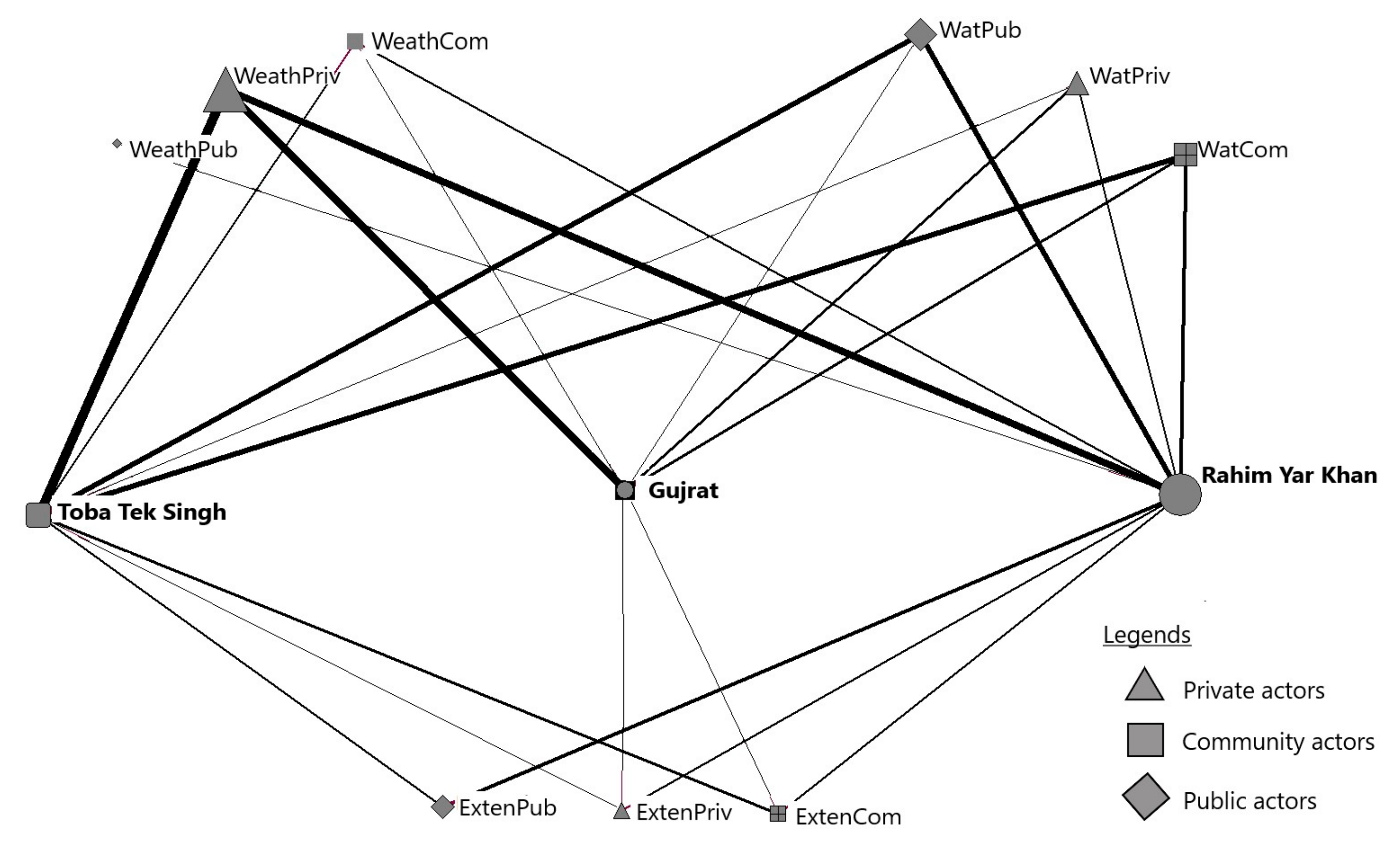
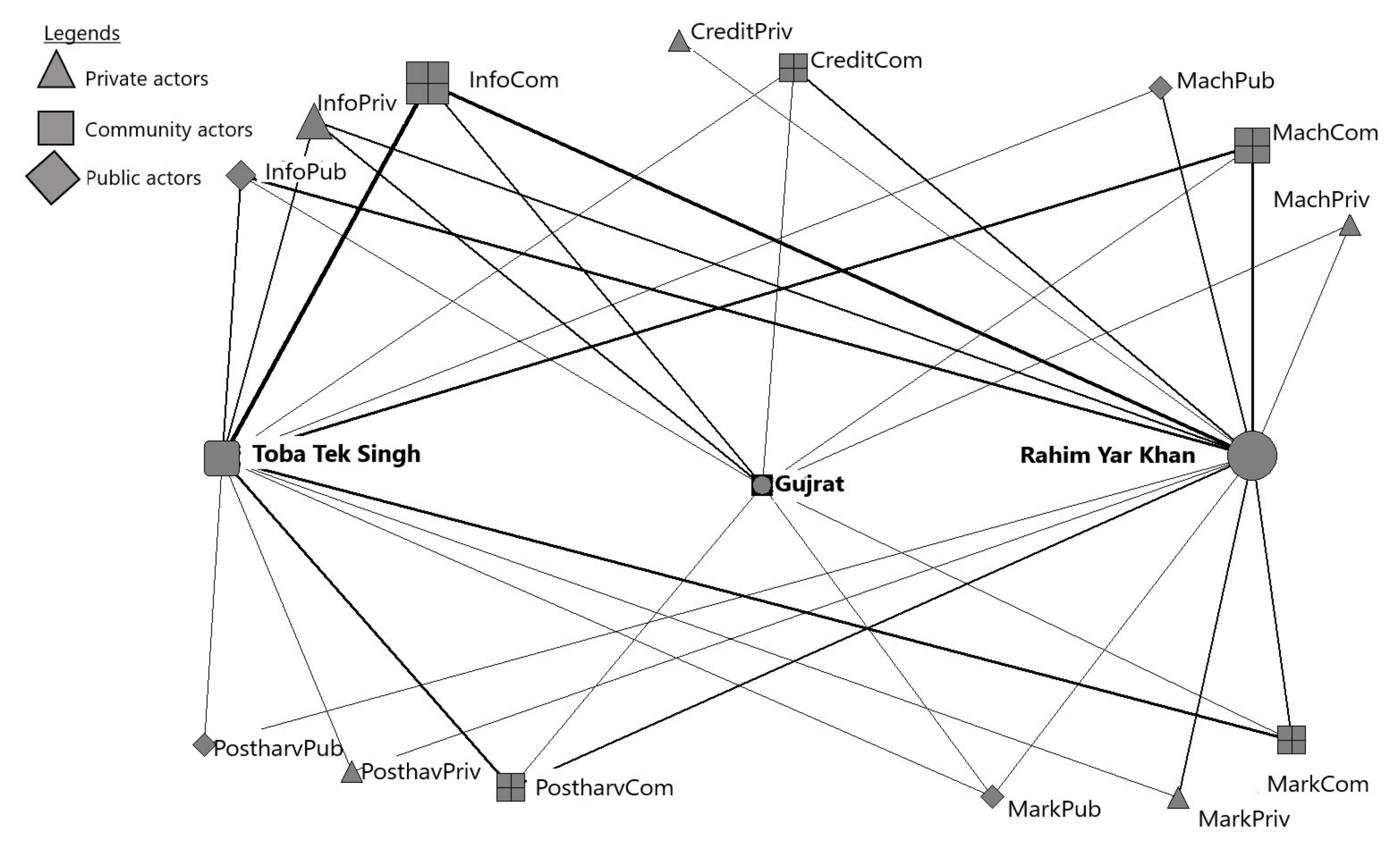
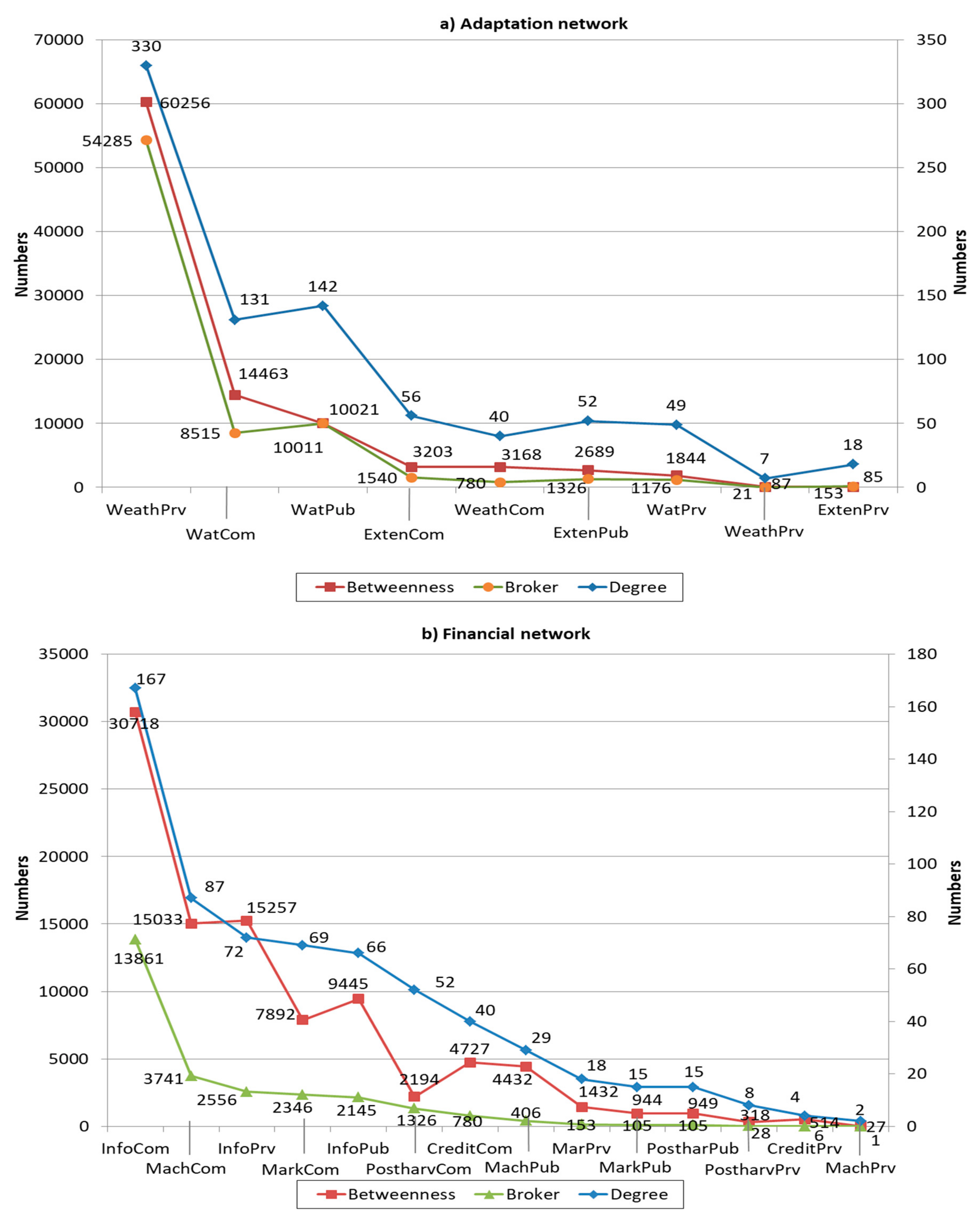

| Variables | Mean | Standard Deviation |
|---|---|---|
| Years of schooling | 8.63 | 4.25 |
| Age (years) | 47.46 | 12.44 |
| Land holdings (hectares) | 6.47 | 11.33 |
| Household size (numbers) | 9.90 | 5.05 |
| Average Income (000 PKR) | 1326 | 98 |
| Agricultural share in total income | 0.71 | 0.49 |
| Non-Agricultural income | 0.29 | 0.36 |
| Credit use | 0.08 | 0.27 |
| Marketing information | 0.64 | 0.48 |
| Access to modern telecommunications (mobile phones, internet) | 0.81 | 0.47 |
| Agricultural extension services | 0.21 | 0.41 |
| Institutions | Location | Type | Services |
|---|---|---|---|
| Agricultural Extension | Regional/village level | Public | Advisory services regarding crop and livestock production |
| On-Farm Water Management | District | Public | Watercourse improvement and subsidized farm implements including water-saving technologies |
| Pest Warning & Quality Control of Pesticides | Sub-district level | Public | Pest scouting, farmer training |
| Punjab Seed Corporation | Sub-district level | Public | Seed sales, farm advisory services, seed quality testing |
| Soil and Water Testing Laboratories | District | Public | Soil and water testing services to farmers |
| Directorate General Agriculture (Field) | District | Public | Land leveling, soil and water conservation and water resource development |
| Directorate of Agriculture (Economics & Marketing) | Provincial/Sub-district level | Public | Online agriculture marketing information service, capacity building at farm level |
| Pakistan Agricultural Storage and Services Corporation | Sub-district level | Public | Marketing of cereal grains |
| Pakistan Meteorology Department | National/provincial | Public | Weather forecasting information |
| Irrigation Department | Sub-district | Public | Irrigation water services |
| ZTBL | Provincial/sub-district | Public | Credit |
| Micro Credit institutions | Sub-district | Private | Credit |
| Input producing and distribution companies | Sub-district/Village level | Private | Input sales and distribution, agricultural information services |
| Friends and colleagues | Village level | Community | Informal credits, farm implements, weather and marketing information, |
| Telecommunication sources (TV/Radio/Internet) | Online/Local | Private | Extension, weather and marketing information |
| Access to Services | Adaptation Response | Adaptation Measures |
|---|---|---|
| Case 1: Simultaneous access to extension services, market and weather forecasting information | 38% | Changing crop varieties, crop types and planting dates |
| Case 2: Services under scenario 1 and access to credit services | 47% | Changing crop varieties, crop types, planting dates, irrigation and input mixes like fertilizer, water and pesticide |
| Case 3: Services under scenario 1 and 2 and access to farm machinery | 51% | Changing crop varieties, crop types, planting dates, irrigation, input mixes, soil and water conservation, tree plantation and farm diversification |
© 2017 by the authors. Licensee MDPI, Basel, Switzerland. This article is an open access article distributed under the terms and conditions of the Creative Commons Attribution (CC BY) license (http://creativecommons.org/licenses/by/4.0/).
Share and Cite
Abid, M.; Ngaruiya, G.; Scheffran, J.; Zulfiqar, F. The Role of Social Networks in Agricultural Adaptation to Climate Change: Implications for Sustainable Agriculture in Pakistan. Climate 2017, 5, 85. https://doi.org/10.3390/cli5040085
Abid M, Ngaruiya G, Scheffran J, Zulfiqar F. The Role of Social Networks in Agricultural Adaptation to Climate Change: Implications for Sustainable Agriculture in Pakistan. Climate. 2017; 5(4):85. https://doi.org/10.3390/cli5040085
Chicago/Turabian StyleAbid, Muhammad, Grace Ngaruiya, Jürgen Scheffran, and Farhad Zulfiqar. 2017. "The Role of Social Networks in Agricultural Adaptation to Climate Change: Implications for Sustainable Agriculture in Pakistan" Climate 5, no. 4: 85. https://doi.org/10.3390/cli5040085
APA StyleAbid, M., Ngaruiya, G., Scheffran, J., & Zulfiqar, F. (2017). The Role of Social Networks in Agricultural Adaptation to Climate Change: Implications for Sustainable Agriculture in Pakistan. Climate, 5(4), 85. https://doi.org/10.3390/cli5040085






